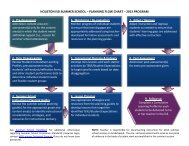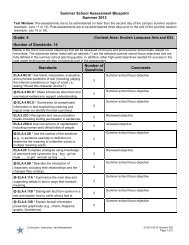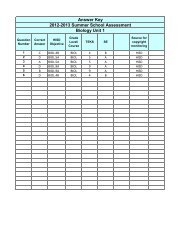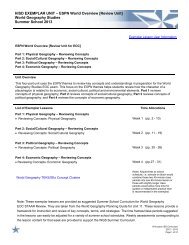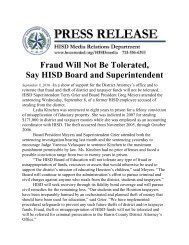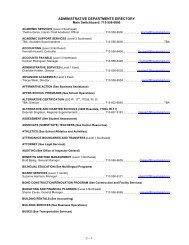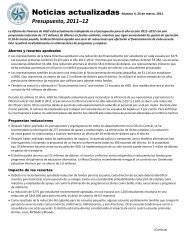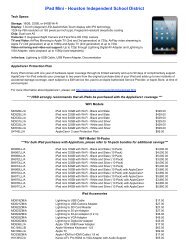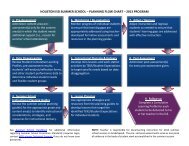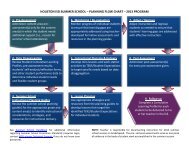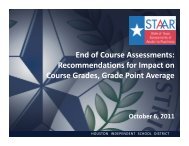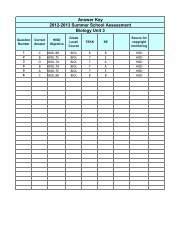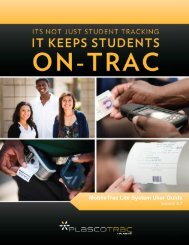SSK Unit 4.2 Planning Guide
SSK Unit 4.2 Planning Guide
SSK Unit 4.2 Planning Guide
You also want an ePaper? Increase the reach of your titles
YUMPU automatically turns print PDFs into web optimized ePapers that Google loves.
Instructional ConsiderationsHISD PLANNING GUIDEEnglish Language Arts Grade 8SUMMER SCHOOLInstructional Accommodations for Diverse Learners Present ELLs with mini-lessons on how nonfiction writers organize their ideas into text structures. ELLsneed to learn the signal words that show how an author has organized his/her work. Post in theclassroom and distribute to students. See Resources for Signal Words and Graphic Organizers forIdentifying Text Structure.Introduce students to Literature Circles as a means to discuss and interact with the text. Provide opportunities duringLiterature Circles for hands-on experience to reinforce the content. Activities with sentence strips or index cards can bedesigned and used to categorize or combine information, to distinguish importance of information, or to arrangeinformation or events in a sequence or other organizational pattern. Provide short newspaper articles for students tocategorize based on organizational patterns. See Resource Manager Grade 8, <strong>Unit</strong> 8 in Resources.Instructional Accommodations for Diverse Learners To encourage ELLs to read silently for longer periods, have them complete reviews of texts read inclass that can be published for others to read. See Navigating the ELPS in the English Language Artsand Reading Classroom in Resources. (ELPS C.4h)Review main ideas and supporting details. Model the process of discerning main idea from supporting details throughThink-Alouds. See Main Idea Web in Instructional Strategies. See Best Practices Toolkit and Resource Manager Grade8, <strong>Unit</strong> 8 in Resources. (ELA.8.10A, ELPS C.2h,)Next, review the process of creating summaries with students. Remind students of the differences between main ideasand summaries. Teach students to analyze and use organizational patterns when creating summaries. For example, ifthe overall pattern is cause and effect, the summary should have a cause and effect structure. Use Summary Frames toassist students in creating effective summaries. See Marzano’s Classroom Instruction that Works in Resources. SeeInstructional Strategies for Summary Frames.Focus on students using summarization skills to identify information from which to make inferences. Remind studentsthat an inference is a combination of what the text tells the reader and the knowledge and experiences of a reader.Instruct students to use text evidence to support an assertion or inference. Model how to locate and extract textevidence through Think-Alouds. This mental process is more important initially than a formal written response. Thefocus should be on why a particular piece of text evidence was chosen and what logical inferences or conclusions canbe drawn. See Inference Chart and Making Inferences in Instructional Strategies. (ELA.8.10C)Provide students with a checklist to assist in making inferences. Include: Did I make sure my inference relies mainly on the author’s words rather than my experiences or feelings? Did I check to see if my inference is contradicted by any statements in the text? Can I identify statements that lead to my conclusion/ inference?Review facts and opinions and have students practice identifying facts and opinions. See Instructional Strategies forFact Vs. Opinion Chart. See Resources for Finding Facts and Opinions.Draw students’ attention to the author’s use of facts and opinions in a text. Explain that the reason an author uses a factor an opinion is to further support his/her claim or assertion. Have students make inferences and draw conclusions as tothe author’s purpose behind including particular facts and opinions. Encourage students to ask themselves: Does the author use facts or opinions to explain their thinking? What are these facts and opinions suppose to make me think? How effective are they in achieving the author’s goal?Remind students to keep all work pertaining to reading in their Literacy Notebooks. See Instructional Strategies for Factor Opinion and Author’s Purpose. See Best Practices Toolkit in Resources for Distinguishing Fact and Opinion.(ELA.8.9A)Instructional Accommodations for Diverse Learners ELLs need the opportunity to explain their thinking. The Numbered Heads Strategy enables all - English Language Proficiency Standards (ELPS) - Literacy Leads the Way Best Practices - Aligned to Upcoming State Readiness Standard- State Process Standard R - State Readiness Standard S - State Supporting Standard© Houston ISD Curriculum2013 – 2014Page 4 of 9




